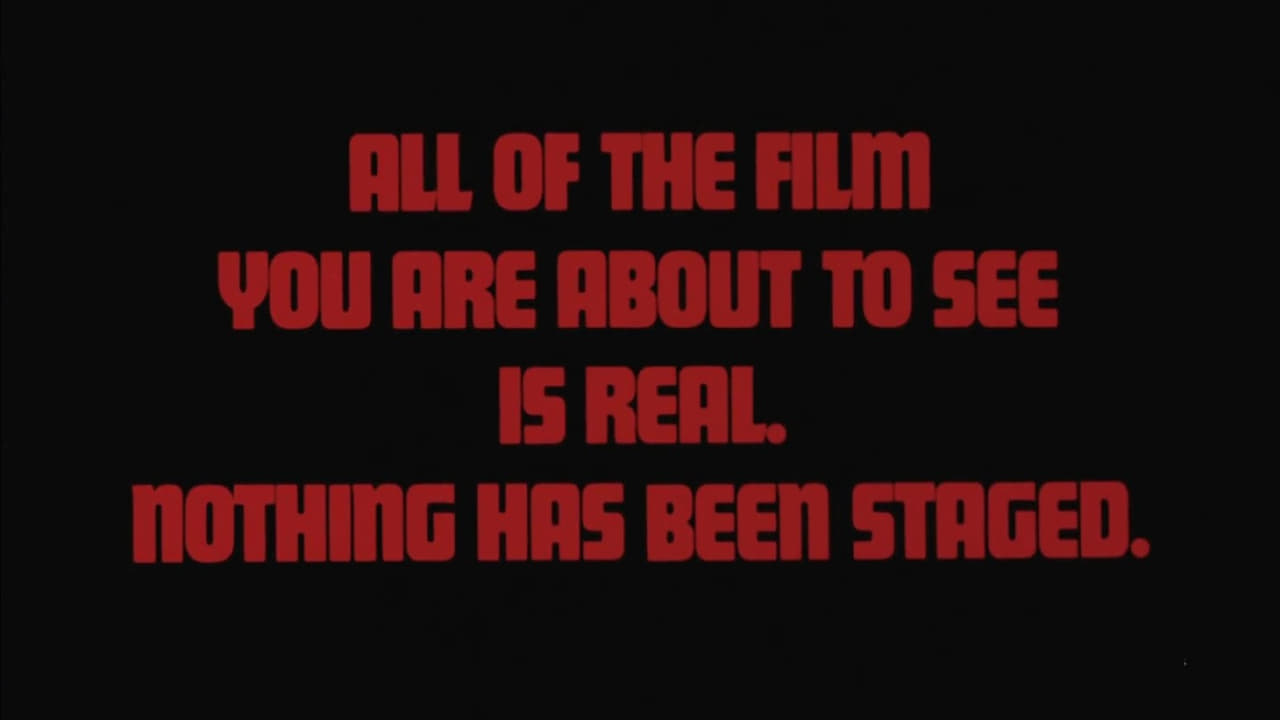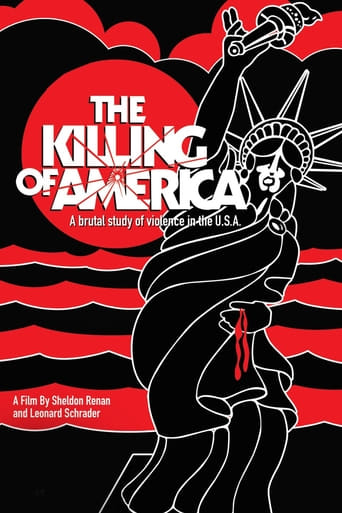

The greatest movie ever!
... View MoreI really wanted to like this movie. I feel terribly cynical trashing it, and that's why I'm giving it a middling 5. Actually, I'm giving it a 5 because there were some superb performances.
... View MoreAll of these films share one commonality, that being a kind of emotional center that humanizes a cast of monsters.
... View MoreExactly the movie you think it is, but not the movie you want it to be.
... View MoreIt's a documentary in the mold of the mondo films or Faces of Death, and the film mostly consists of archival footage, but some of it appears to have been shot by a cameraman specifically for the film (The Kennedy assassination zoom in shots on the window and tracking shot inside the interior where Oswald fired and the man demonstrating Whitman's behavior appeared as if they might have been made just for this film, as well as some of the earlier footage). Obviously don't watch it if you're unwilling to see violent and gruesome images. Often it just discusses the material and has little graphic material to show, but they don't shy away from people being shot on screen and even a few suicide or after death photos.The beginning was the most interesting part because all of the footage was just everyday violent scenes and showcased the gritty streets of the most dangerous American cities. It seemed initially like it had an underlying message and was more artfully directed than something like FoD. Quite a depressing atmosphere to the whole thing, but then all of the iconic scenes of successful or attempted assassinations of famous figures (Wallace, Reagan, MLK, JFK, and his brother Robert), followed by a few mass shootings/snipers, serial killers, Jonestown, etc. occurred--some more obscure than others. Though it's interesting if you haven't seen a lot of this footage, it does become a bit rote, especially if you're familiar with any of the content. I'd already seen the footage from Bundy and Kemper, and a few others--unfortunately, most of the archival footage is not edited together in a unique way and has rather banal commentary.Aside from some occasionally inventive editing and the strong start, and some decent music choices, most of the footage is available on Youtube, and this is only of note as a clip compilation film with little direction other than to document a bunch of violent scenarios, usually by category rather than chronologically. It offers no real insight into the American condition, why the violence occurs, or how to ameliorate it, and very few statistics (all shoehorned in at the beginning). It's also wrong at a few points--average IQ for murderers of the type presented tend to be below 100, but the more charming and higher IQ killers usually get all the media attention (Might have been flimsy data at the time, but I'm just pointing that out). As well as the odd suggestion that people in prison for life or with a long sentence would be released because of prison overpopulation or something (They presumed Sirhan Sirhan would be released just 3-4 years after the film debuted in '81). Absolutely no documented information is included to substantiate any of these claims or even any concrete examples are given (they could have at least interviewed a few cops or legislators or something). The ending with Lennon's peace vigils is rather tepid, but it seems they were pressured to end on a more positive note.A quick listing of footage or details in the film: Wallace, Lennon, Reagan, MLK, JFK, and his brother Robert (there are also Sirhan Sirhan interviews), all either successfully or unsuccessfully assassinated; Ted Bundy, Edmund Kemper, Wayne Henlon and Dean Corll, Brenda Spencer, John Wayne Gacy, Mark Essex (and two others), Charles Whitman, Jonestown Massacre, Tony Kiritsis, Manson Family, Robert Smith, James Hoskins, and some very brief footage of the Vietnam War. There's some other content, but that's the bulk of it.
... View MoreThis documentary about the appalling mass epidemic of random and widespread gratuitous violence that initially started sweeping across America in the early 1960's might make for decidedly uncomfortable viewing, but it nonetheless does a frightfully persuasive job of illustrating that violence is a dangerous sickness with no immediate foreseeable end or cure in sight.Directors Sheldon Renan and Leonard Schrader pull no punches in their alarming catalogue of all kinds of grim and unpleasant atrocities: The assassinations of John and Robert Kennedy, Martin Luther King, and John Lennon, the heinous misdeeds of such notorious serial killers as Ted Bundy, David Berkowitz, John Wayne Gacy, the Hillside Strangler, and Dean Corll, the attempted assassinations of George Wallace and Ronald Reagan, the Charles Whitman shootings at the University of Texas in Austin, the tragic shooting of several student protesters at Kent State University, the horrifying schoolyard killings committed by Brenda Spencer, the equally upsetting Jonestown mass suicides, and other such in-your-face bleak occurrences are addressed in an unwaveringly stark and straightforward manner. Chuck Riley handles the narrator chores with appropriate solemnity. The flesh-crawling score by Mark Lindsay and W. Michael Lewis does the spine-tingling trick. The rough cinematography provides a suitably gritty look. Loaded with hideously explicit photos and newsreel footage, this notorious mondo shock doc packs a savage punch right to the gut.
... View MoreA documentary of the so-called "decline" of America, said to begin with the Kennedy assassination. It features a lot a great footage (most of it exclusive to this film) from race riots to serial killers and much, much more.This really does show it all: cops shooting suspects, political assassinations, the Jim Jones cult and such notorious figures as Charles Manson and Ted Bundy. The most disturbing part is an interview with Edmund Kemper, an "American who killed Americans". Although not as famous (or infamous) as Manson or Bundy, Kemper talks of killing his victims in a very casual way, and is rather intimidating -- he looms at almost 7 feet in height! As an interesting side note, the narration is done by Chuck Riley (known for his movie trailer dialogue), who coincidentally had known Jack Ruby. What it was like to narrate a scene of Ruby killing Oswald when he had a personal connection is something we can only wonder about.Although not mentioned in the film, a Los Angeles police officer claimed that every officer who shot and killed a suspect would retire within four years because of the psychological damage it caused. This would be an interesting stat to look into. Is it true? Has it changed?"The Killing of America" was initially shown in New York City in 1982 at the Public Theater, but never received a commercial release in the United States. It did receive a home video release in Britain, and a wide release in Japan, where financial backers reportedly pressured the director to add footage of peace vigils for John Lennon as a way to make the documentary less depressing. Years later the documentary would receive a 2013 North American release at Fantasia Festival in Canada (which is a bit odd, as the film has no "fantastic" elements). And in 2016, thanks to Severin, it now gets a full Blu-ray treatment.Critic Eleanor Minnikka wrote, "Rather than an in-depth study of the reasons for and effects of the rising murder rate in the U.S., the director has chosen to emphasize the violence and the need for gun control to help lower the appalling amount of mayhem that distinguishes the U.S. from its European counterparts." Minnikka raises a good point that the film is more a showcase of violence rather than any actual study of it. Perhaps more interesting is how violent crime today (2016) is actually on a decline from the 1970s and 1980s -- what happened since this film was made to change the trend? The Blu-ray from Severin features new interviews with editor Lee Percy and director Sheldon Renan, and an audio commentary from Renan, who explains in detail his background, his association with the Schrader brothers and the genesis of the film. Who knew that renting the Zapruder film cost an astounding $20,000? Renan, who (rightly) considers Kennedy a "hawk", suggests he is not a believer in the lone gunman theory. While this has no bearing on the film, it is interesting to note because of the central role JFK plays in the narrative.One of the more interesting inclusions on the disc is a brief discussion of "Mondo" films and the place of this movie in that trend. While I would hesitate to put "Killing of America" in the same category as "Mondo Cane" or "Faces of Death", a case can be made for a connection. Not only do each feature real scenes of graphic violence, but "Killing", like "Faces", had its biggest success in Japan. Why Japan? Hopefully the Blu-ray allows "Killing of America" to be properly appreciated in its home country, as it has some shocking lessons to offer.
... View MoreViolence is the theme of "The Killing Of America", a visually graphic compendium of murder in the U.S.A. "Guns and more guns" intones the narrator, as shots are fired, victims fall, chaos ensues, and the killer's face appears on screen ... over and over and over, one crime after another. Watching this film you'd think that there's a killer hiding behind every bush.Beginning with the JFK assassination and progressing to the early eighties, the film compresses some twenty years of violence into ninety minutes, giving a somewhat distorted cultural impression. How does the murder rate during those twenty years compare to prior decades? The film doesn't tell us. How does that period compare to more recent times? The film can't tell us. So that one problem with "The Killing Of America" is that it is time-bound, stuck in a particular era, without reference to the past or future.One might also ask ... how does American gun violence compare to other countries? The film compares the U.S. to Japan and England, which have ultra-low murder rates. Beyond that, the film doesn't say. Recent statistics show that in comparison to other industrialized nations, the U.S. has a higher murder rate than any country except Russia. But when compared to non-industrial countries, like Honduras, Venezuela, and the Ivory Coast, violence in America is quite low. So a second problem with the film's message is lack of adequate geographic perspective.There's also a problem with the film's structure. Although there's a general chronological progression of events, I cannot justify the film's sequential positioning of different types of gun violence, for example, a political assassination followed by some local neighborhood murder, followed by an expose on a highly publicized serial killer. Such sequencing is haphazard and arbitrary. Apart from the obvious violence, what is the unifying theme in this jumble of cases?The visuals in the copy I watched are poor with lots of out-of-focus scenes, though that can partly be explained by impromptu photography. Overall images trend a little too dark. Sound quality also is poor in spots. Most background music is a bit too frenzied and too loud. John Lennon's song "Imagine" provides a welcome reprieve at the end.There is no question that the level of violence in the U.S. was then, and still is, too high. "The Killing Of America" does indeed provide factual information, with very good video footage of local murders and highly publicized national cases. But the political bias toward gun control is blatant. And the overall production suffers from morbid exploitative visuals at the expense of calm, rational analysis.
... View More